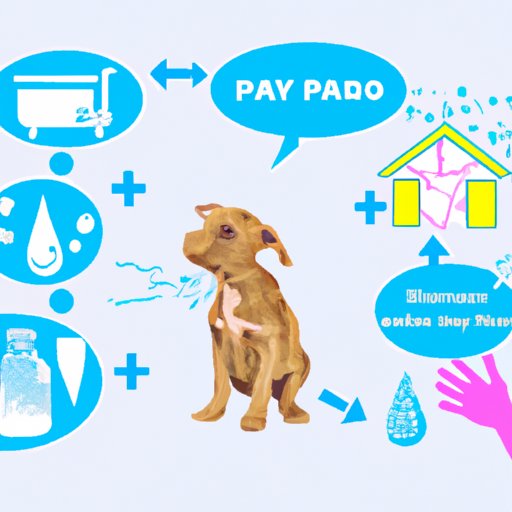Introduction
Parvovirus is a serious and often fatal illness caused by a virus that affects dogs. It is highly contagious and can spread quickly through contact with other animals, surfaces, or objects. The virus is typically found in contaminated feces and can survive for months in the environment. If left untreated, parvo can cause severe dehydration, vomiting, diarrhea, weakness, and even death.
Although treatment of parvo should always be done under the supervision of a veterinarian, there are some steps you can take at home to help your pup fight the virus. This article will provide an overview of how to treat parvo at home, including providing a clean and comfortable environment, monitoring symptoms, offering proper nutrition, and administering medications.
Providing a Clean, Comfortable Environment
The first step in treating parvo at home is to create a safe and comfortable space for your pup. This includes keeping them away from other animals and surfaces they can come into contact with, as the virus can be easily spread. Set up a quiet area with a bed or crate, toys, and plenty of ventilation to keep them comfortable while they recover.
You should also take extra precautions to maintain hygiene. This includes washing your hands before and after handling your pup and any of their belongings, as well as regularly cleaning their bedding and toys. Disinfecting surfaces that your pup has been in contact with can also help reduce the risk of the virus spreading.
Monitoring Symptoms
It’s important to monitor your pup’s symptoms during their recovery. Common signs of parvo include vomiting, diarrhea, loss of appetite, lethargy, and dehydration. If your pup begins to display any of these symptoms, it’s important to consult your veterinarian immediately as parvo can be fatal if left untreated.
Your vet may also recommend additional tests or treatments to ensure your pup is receiving the best care possible. This could include blood tests, x-rays, or other forms of diagnostics to determine the severity of the infection.
Hydration
One of the most important factors in treating parvo is ensuring your pup is properly hydrated. Offer them fresh water throughout the day, and replace the water bowl daily to prevent contamination. You can also offer ice cubes or canned food to encourage them to drink more. If your pup is unable to drink on their own, your vet may recommend intravenous fluids to prevent dehydration.
Diet
When it comes to feeding your pup during their recovery, it’s important to provide the right type and amount of food. Your vet may recommend a specific type of food for your pup, such as a special diet or homemade meals. It’s also important to feed your pup smaller meals throughout the day, as large meals can worsen their symptoms.
If your pup isn’t able to eat solid food, they may benefit from feeding tubes or syringes to get the nutrients they need. This should always be done under the supervision of a veterinarian.
Medications
Your veterinarian may recommend certain medications to help your pup fight the virus. This could include antibiotics, anti-nausea medications, pain relievers, or supplements. It’s important to follow your vet’s instructions carefully when administering any medications, and never give your pup any over-the-counter medications without consulting a vet first.
Cleaning and Disinfecting
Cleaning and disinfecting are essential steps in treating parvo at home. This includes regularly washing your pup’s bedding and toys, as well as disinfecting any surfaces they have been in contact with. Be sure to use a bleach solution to effectively kill the virus, and always wear protective gloves and a face mask when cleaning.
It’s also important to take the necessary precautions when disposing of any materials that have come into contact with the virus. This includes wearing gloves and a face mask when handling any contaminated items, and double-bagging them before throwing them away.
Conclusion
Treating parvo at home can be a challenging process, but with the right steps, it is possible to help your pup recover. This includes providing a clean and comfortable environment, monitoring symptoms, offering proper hydration and nutrition, administering medications, and cleaning and disinfecting any contaminated surfaces. With the correct treatment, your pup can make a full recovery.
Remember to always consult your veterinarian for advice on how to best care for your pup. They can provide guidance on the best course of action for your pup’s individual needs. With the right care and attention, your pup can make a full recovery.


